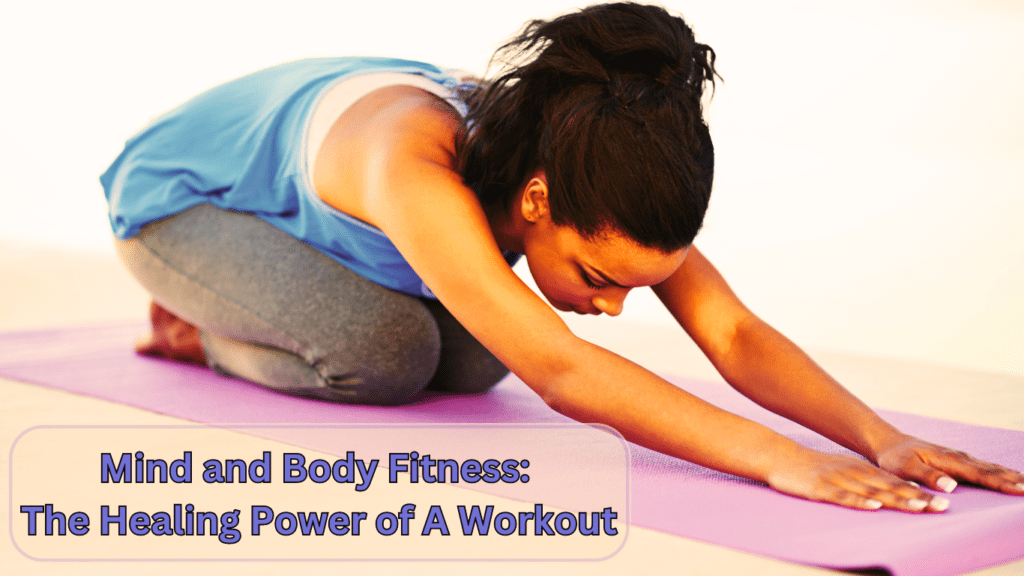Understanding Sleep Apnea and How Yoga Breathing Exercises for Sleep Apnea Can Help
In this article, we will delve into the science behind yoga breathing exercises for sleep apnea, offering practical techniques to improve your sleep quality and overall health while explaining how these exercises work to alleviate symptoms effectively.
Did you know that more than 18 million American adults suffer from sleep apnea? This common sleep disorder affects millions globally, yet many people don’t realize that yoga breathing exercises can help manage its symptoms. Often underestimated, these techniques can significantly improve respiratory function and help alleviate the discomfort caused by sleep apnea. In this article, we’ll explore how yoga breathing exercises for sleep apnea may offer relief to those dealing with this challenging condition.

Sleep apnea is a disorder characterized by repeated interruptions in breathing during sleep. These interruptions occur because the airway becomes blocked or collapses, causing the person to briefly wake up, often without even realizing it. There are three main types of sleep apnea:
- Obstructive Sleep Apnea (OSA): The most common form, this occurs when the throat muscles relax excessively during sleep, blocking the airway.
- Central Sleep Apnea (CSA): This type is less common and involves the brain failing to send the proper signals to the muscles that control breathing.
- Complex (or Mixed) Sleep Apnea: A combination of both obstructive and central sleep apnea.
Symptoms of sleep apnea can include loud snoring, gasping or choking during sleep, daytime fatigue, morning headaches, and even insomnia. Some people may experience memory or concentration issues as well. While sleep apnea can affect anyone, certain risk factors increase the likelihood of developing the condition. These include age, obesity, smoking, and alcohol consumption. Additionally, those with a family history of sleep apnea or certain medical conditions (like high blood pressure) are more at risk.
Subscribe And Get Our Free E-Book:Unlocking The Power Of Nutrition-Supplements, Substitutes, and Superfoods!
Understanding why breathing is crucial in sleep apnea helps explain why yoga breathing exercises for Sleep Apnea are worth exploring. Essentially, sleep apnea results from poor airflow during sleep. The muscles in the throat or airway may either collapse or become blocked, making it difficult for air to pass. This leads to frequent interruptions in breathing and a lack of oxygen reaching the brain and body.
This is where pranayama, or yoga breathing exercises, comes into play. These exercises are designed to improve the body’s ability to take in oxygen and promote deep, controlled breathing. Over time, pranayama helps to strengthen the respiratory muscles, increase lung capacity, and improve the overall efficiency of your breathing. This can make a notable difference for someone suffering from sleep apnea, as stronger breathing muscles can reduce the risk of airway collapse during sleep.
One of the core principles behind Yoga Breathing Exercises for Sleep Apnea is that these practices help to keep the airways open by toning the muscles surrounding the throat and chest. These exercises also promote relaxation, which can be especially helpful for those who experience anxiety or stress related to their sleep apnea. Additionally, yoga breathing encourages nasal breathing, which has been shown to help keep the airways clearer compared to mouth breathing. This is crucial for those with sleep apnea, as nasal breathing ensures that the air is filtered, humidified, and warmed before reaching the lungs, reducing the chances of obstruction.
For people looking to manage their sleep apnea symptoms without immediately turning to medical interventions like CPAP machines or surgery, yoga breathing can serve as a natural and non-invasive alternative. That’s not to say that these exercises will “cure” sleep apnea entirely, but they can certainly be a complementary tool in reducing the severity and frequency of apnea episodes.
By committing to regular practice, individuals with sleep apnea may find that these breathing techniques reduce their symptoms and improve their quality of life. It’s essential to note that while Yoga Breathing Exercises for Sleep Apnea can offer significant benefits, they are most effective when combined with other healthy lifestyle changes, such as maintaining a healthy weight, avoiding alcohol before bed, and sleeping in positions that promote open airways.
Sleep apnea is a serious sleep disorder that affects a significant number of people, often without them being fully aware of the underlying issues at hand. By understanding the role that breathing plays in this condition, we can begin to explore alternative approaches to management, including Yoga Breathing Exercises for Sleep Apnea. These exercises are accessible, easy to practice, and, when done consistently, may offer substantial relief for those dealing with the discomfort of interrupted sleep. It’s a simple yet effective way to regain control of your breathing and, ultimately, your sleep.
Chart: How Yoga Breathing Exercises Help Sleep Apnea Symptoms
| Aspect of Sleep Apnea | Impact on Health | How Yoga Breathing Helps | Related Techniques |
|---|---|---|---|
| Interrupted Breathing | Frequent drops in oxygen levels during sleep | Increases oxygen intake, stabilizes breathing patterns | Diaphragmatic Breathing, Ujjayi Breathing |
| Airway Collapse | Blocked or narrowed airways causing sleep disturbances | Strengthens airway muscles to prevent collapse | Kapalabhati, Bhramari |
| Poor Sleep Quality | Leads to daytime fatigue, irritability, memory issues | Promotes relaxation, reducing stress and improving sleep onset | Nadi Shodhana (Alternate Nostril) |
| Low Oxygen Levels | Strain on cardiovascular health | Increases lung capacity and oxygenation | Deep Abdominal Breathing |
| Stress & Anxiety | Aggravates breathing issues, leads to shallow breathing | Calms the nervous system, enhancing relaxation for better sleep | Bhramari, Ujjayi |
What Is Sleep Apnea?
They say snoring is just you getting revenge for all the times your partner woke you up. Funny, but for those suffering from sleep apnea, snoring can be more than just an annoyance. It’s often a sign of a more serious problem. In fact, sleep apnea can lead to health risks like heart disease and high blood pressure if left untreated. So, let’s dive into what sleep apnea really is and why it happens, before we explore how Yoga Breathing Exercises for Sleep Apnea can play a vital role in managing it.
Sleep apnea is more than just loud snoring or an occasional gasp during sleep. At its core, it’s a disorder where your breathing repeatedly stops and starts while you sleep. The interruptions in breathing can last for seconds or even longer, causing your body to wake itself up briefly to restore airflow. These frequent disturbances prevent deep, restful sleep, which is why people with sleep apnea often feel tired, even after what seems like a full night’s rest.
To understand sleep apnea fully, let’s take a closer look at how it works. There are two main ways sleep apnea affects breathing. The first is obstructive sleep apnea (OSA), which is the most common type. In OSA, the soft tissues in the back of your throat (including the tongue and the uvula) relax too much during sleep. When this happens, the airway becomes either partially or completely blocked, preventing oxygen from reaching your lungs. The result? You stop breathing until your body jolts you awake—usually with a choking sound or gasp for air.

The second type is central sleep apnea (CSA), which happens when your brain fails to send the correct signals to the muscles that control breathing. Unlike obstructive sleep apnea, where the airway physically collapses, in CSA, the problem is neurological. The brain simply doesn’t communicate properly with the muscles, leading to pauses in breathing. There’s also a mixed or complex form of sleep apnea, which is a combination of both OSA and CSA.
Why is sleep apnea dangerous? Well, the effects extend far beyond poor sleep. Every time your airway closes or your brain “forgets” to breathe, the oxygen levels in your blood drop. Over time, this can strain your cardiovascular system. People with untreated sleep apnea are more likely to develop high blood pressure, heart disease, stroke, and even type 2 diabetes. Since your body is constantly being jerked awake throughout the night to restart your breathing, your stress hormones increase, which can lead to chronic inflammation and other long-term health complications.
The physiology of breathing in sleep apnea reveals even more about the condition. In people with sleep apnea, the muscle tone in the airway is weakened. This means that the muscles responsible for keeping the airway open are not as strong as they should be, which leads to the airway collapsing during sleep. Along with poor muscle tone, reduced lung capacity is another common issue. When you’re not breathing efficiently, your lungs aren’t able to fully expand, limiting the amount of oxygen you take in. This leads to lower oxygen levels in the blood, affecting your brain and body’s ability to function properly. Inadequate oxygen intake during the night can leave you feeling fatigued and mentally foggy during the day, which is why the quality of sleep is so critical.
In sleep apnea, these problems arise because normal breathing patterns are disrupted. When you’re awake, your body naturally keeps your airway open and your breathing smooth. But when you fall into deeper stages of sleep, your muscles relax. If you have sleep apnea, this relaxation can cause a collapse or blockage in your airway, reducing your airflow and forcing your brain to interrupt your sleep to correct the problem. Over time, these frequent interruptions make it impossible to achieve deep, restorative sleep, leaving you feeling exhausted even after a full night in bed.
This is where the impact on sleep quality becomes clear. Since your body is constantly being pulled out of the deeper stages of sleep, fragmented sleep becomes the norm. You never truly reach the deeper, more restorative levels of sleep, which are necessary for both physical and mental recovery. Chronic fatigue is a common result, and it can severely affect your quality of life. People with sleep apnea often struggle with daytime sleepiness, reduced concentration, and even mood disturbances like irritability or depression. Over time, this constant feeling of exhaustion can affect both your personal and professional life, as you’re always running on a sleep deficit.
So, what can be done about it? That’s where the practice of Yoga Breathing Exercises for Sleep Apnea comes into play. These exercises focus on strengthening the muscles involved in breathing, improving lung capacity, and promoting more efficient, controlled breathing patterns. By incorporating these exercises into your routine, you can potentially reduce the severity of your sleep apnea symptoms, improving both your breathing and sleep quality.
In summary, sleep apnea is a serious condition that disrupts normal breathing during sleep, leading to significant health risks if left untreated. The collapse of airways and interruptions in brain signals to breathe make this condition a serious concern. But with the right approach, including Yoga Breathing Exercises for Sleep Apnea, individuals can take control of their breathing and find relief from the constant fatigue and health risks associated with this condition.
The Connection Between Breath and Sleep Apnea
Here’s an interesting fact: the average person takes about 20,000 breaths a day—and most of us never even think about it. But if you suffer from sleep apnea, breathing, especially during sleep, becomes a challenge. This is where yoga breathing exercises for Sleep Apnea can come in handy, helping to regulate your breathing, strengthen respiratory muscles, and reduce those dangerous interruptions during the night. In this part, we’ll explore the vital connection between breathing and sleep apnea, and how proper breath control can make all the difference.
Breathing is an automatic process that most people rarely pay attention to, but for individuals with sleep apnea, the way they breathe, especially during sleep, has a significant impact on their condition. Sleep apnea occurs when the airway collapses or becomes obstructed during sleep, making it difficult to breathe naturally. This is where understanding diaphragmatic breathing becomes crucial. Diaphragmatic breathing, also known as “belly breathing,” uses the diaphragm, the large muscle beneath the lungs, to pull air deep into the lungs. Unfortunately, many of us tend to engage in shallow chest breathing, which only uses the upper part of the lungs and is far less efficient.
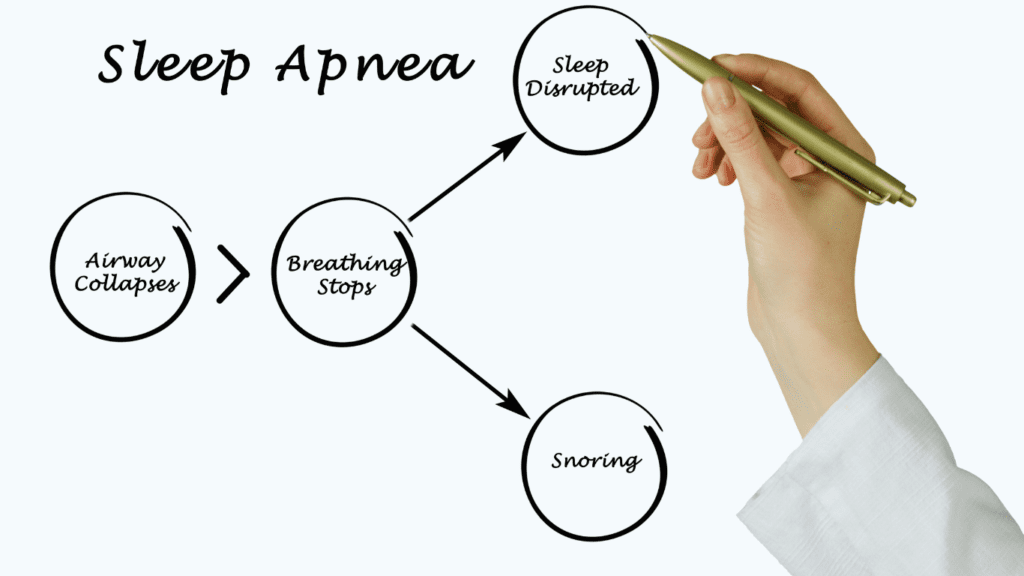
Diaphragmatic breathing helps improve lung efficiency by allowing more air to enter the lungs with each breath. This deeper style of breathing increases oxygen exchange and supports better airflow, which is essential for people with sleep apnea. When you engage the diaphragm fully, it expands the lungs more efficiently, helping to prevent airway collapse. Since sleep apnea is largely a condition of airway obstruction, breathing properly with the diaphragm can significantly reduce the risk of these blockages occurring during sleep. Practicing diaphragmatic breathing during the day trains your body to adopt this more effective breathing pattern at night, promoting a more restful sleep experience.
Beyond diaphragmatic breathing, Yoga Breathing Exercises for Sleep Apnea can help by strengthening the respiratory muscles. In people with sleep apnea, the muscles around the airways, especially the throat, are often weak, which increases the likelihood of airway collapse. Yoga breathing exercises, or pranayama, are specifically designed to engage and strengthen these muscles. By practicing certain breathing techniques, you actively work the muscles involved in respiration, toning them over time. This increased muscle strength helps to keep the airways open, reducing the likelihood of airway obstruction during sleep.
Moreover, these exercises aren’t just about the muscles around the airways; they also help improve lung capacity. Over time, people who practice pranayama find that their lungs can hold more air, which leads to better oxygenation of the blood. In the context of sleep apnea, better lung capacity means that even during brief moments of airway obstruction, the body is better able to compensate by delivering oxygen to the brain and other organs. This can help reduce the severity of sleep apnea episodes, improving overall sleep quality.
Additionally, pranayama exercises help to regulate the nervous system, which is essential for people with sleep apnea. Sleep apnea is often associated with elevated stress levels, as the frequent interruptions in sleep trigger the body’s fight-or-flight response. Yoga breathing exercises help calm the nervous system, reducing the body’s stress response and promoting a more relaxed state before bedtime. This relaxed state can help prevent the sudden disruptions in breathing that occur during sleep, making pranayama a beneficial practice for those with sleep apnea.
Another crucial aspect of Yoga Breathing Exercises for Sleep Apnea is the role they play in increasing oxygen supply. Controlled breathing techniques, such as alternate nostril breathing or deep abdominal breathing, focus on maximizing the amount of oxygen the body takes in with each breath. For individuals with sleep apnea, increasing oxygen intake is essential because it helps to counteract the frequent drops in blood oxygen levels that occur during apneic events. When you practice deep, controlled breathing, you train your body to take in more oxygen efficiently, which can help minimize the impact of the breathing pauses characteristic of sleep apnea.
In addition to increasing oxygen supply, yoga breathing exercises help improve overall breath control. Many people with sleep apnea struggle with erratic or shallow breathing patterns during the night, which worsens their symptoms. By practicing pranayama, you can gain better control over your breath, ensuring that each breath is deep, steady, and consistent. This control is particularly important because erratic breathing can lead to increased airway instability, making it more likely for an obstruction to occur. Practicing pranayama during the day can train the body to maintain this steady, controlled breathing even during sleep, helping to reduce the frequency of apneic episodes.
Incorporating Yoga Breathing Exercises for Sleep Apnea into your daily routine can offer a range of benefits, from strengthening respiratory muscles to increasing lung capacity and oxygen supply. These exercises not only target the physical aspects of breathing but also have a profound effect on the nervous system, helping to reduce stress and promote relaxation. When practiced consistently, pranayama can help alleviate the symptoms of sleep apnea by ensuring that the airways remain open and that the body is receiving the oxygen it needs during sleep.
The connection between breath and sleep apnea is critical. Poor breathing patterns, weakened airway muscles, and reduced oxygen intake all contribute to the severity of sleep apnea. However, by focusing on diaphragmatic breathing, strengthening the muscles that control respiration, and increasing oxygen supply through pranayama, individuals with sleep apnea can take steps toward improving their sleep quality. With regular practice, Yoga Breathing Exercises for Sleep Apnea can become a key component in managing the condition, providing a natural, non-invasive way to improve breathing and reduce the risks associated with sleep apnea.
Sleep Apnea- 3 minutes Yoga Breathing Video
The Power of Yoga Breathing Exercises for Sleep Apnea: Enhancing Your Sleep Quality
They say, “If you think you’re too busy to meditate, you probably need to meditate twice as much.” Well, the same logic can apply to breathing. If you think you’re too busy to focus on your breathing, chances are you need it even more—especially if you’re dealing with sleep apnea. Breathing is something we do without thinking, yet the way we breathe can have a huge impact on our sleep quality. Practicing yoga breathing exercises for sleep apnea can help people breathe better, sleep deeper, and improve their overall well-being.
What Is Pranayama?
Pranayama is an ancient yoga practice focused on controlling the breath to promote better physical and mental health. In Sanskrit, “prana” means life force or breath, and “ayama” means control or extension. The idea behind pranayama is simple: by mastering your breath, you can positively influence both your body and mind. The practice involves a series of exercises that emphasize slow, rhythmic breathing, breath retention, and breath awareness.
The fundamental principle of pranayama is that when we breathe slowly and mindfully, we reduce stress on our nervous system and improve oxygen flow to our body. By focusing on the breath, we become more in tune with how our body operates, which allows for a more conscious approach to our breathing patterns. For individuals with sleep apnea, this kind of breath control can be especially beneficial because it addresses both the physical and mental components of breathing.
There are several pranayama techniques, but all share the same goal: to help regulate and improve the natural rhythm of your breath. This leads to better lung function, increased oxygenation, and, crucially, a reduction in the types of airway obstructions that can cause sleep apnea episodes. It’s no wonder that yoga breathing exercises for sleep apnea are gaining attention as a non-invasive, effective way to manage the condition.
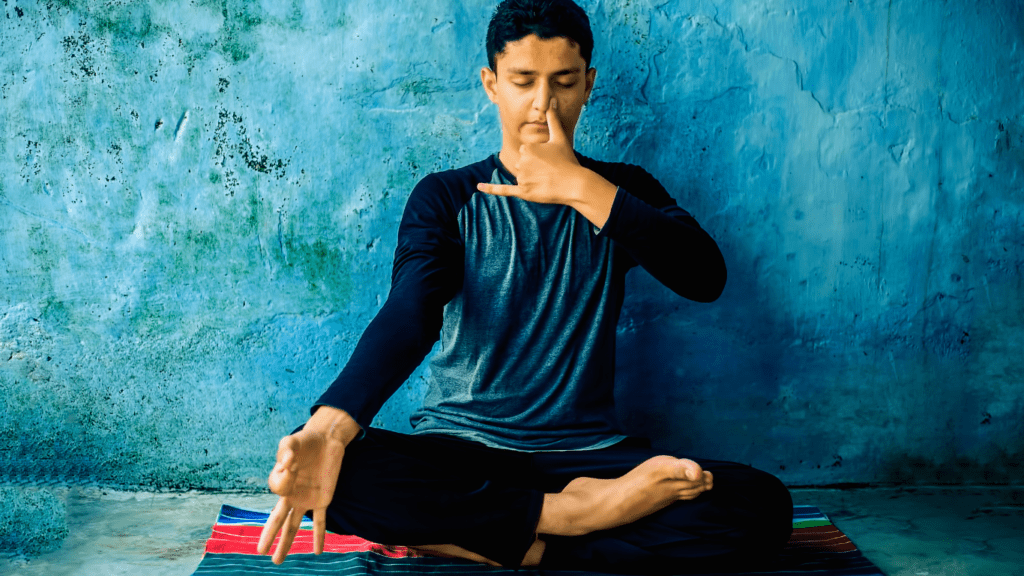
Why Pranayama Works for Sleep Apnea
Yoga breathing exercises for sleep apnea are particularly effective because they target key areas that contribute to the condition: airway obstruction, poor breathing patterns, and stress-related sleep disruptions. Here’s how pranayama addresses these challenges:
- Physical Benefits of Pranayama
- Strengthening the Respiratory System: One of the biggest benefits of pranayama for sleep apnea is how it strengthens the respiratory muscles. Many individuals with sleep apnea experience airway collapse due to weak muscles in the throat and chest. Yoga breathing exercises, such as Ujjayi (victorious breath) and Kapalbhati (skull-shining breath), engage these muscles, toning and strengthening them over time. This can help reduce the chances of airway obstruction during sleep.
- Improved Lung Capacity: Slow, deep breathing exercises improve lung capacity, allowing individuals to take in more oxygen with each breath. For people with sleep apnea, increasing lung capacity can ensure that they receive adequate oxygen even during moments when breathing is obstructed or paused during sleep.
- Enhanced Oxygen Flow: Controlled breathing improves the flow of oxygen to the blood and brain, which helps counteract the negative effects of sleep apnea. Episodes of apnea are characterized by a drop in blood oxygen levels, which can cause fatigue, poor cognitive function, and other health issues. Practicing yoga breathing exercises for sleep apnea helps optimize oxygen intake, reducing these risks.
- Mental and Nervous System Benefits
- Relaxation and Stress Reduction: Stress is known to exacerbate sleep apnea, as it can lead to shallow, irregular breathing patterns that disturb sleep. Pranayama promotes relaxation by engaging the parasympathetic nervous system, which is responsible for rest and recovery. Deep breathing exercises like Nadi Shodhana (alternate nostril breathing) calm the mind and lower stress levels, creating the ideal environment for restful sleep.
- Improved Breath Awareness: One of the core principles of pranayama is developing greater awareness of how you breathe. By practicing mindful breathing, you train your body to recognize when it’s falling into unhealthy breathing patterns—such as shallow chest breathing. Over time, yoga breathing exercises for sleep apnea can help individuals to adopt better breathing habits, not just during practice but also while sleeping.
- Breath Retention: Many pranayama exercises incorporate breath retention (holding the breath), which can help train the lungs and diaphragm to function more efficiently. Breath retention teaches the body to handle short periods without oxygen, mimicking some of the challenges faced during sleep apnea episodes. This can help the body cope better with periods of reduced oxygen during sleep.
How Pranayama Reduces Airway Obstruction
The main cause of sleep apnea is airway obstruction, which happens when the muscles around the throat relax too much during sleep. This is especially common in obstructive sleep apnea, the most prevalent form of the condition. When the airway becomes blocked, it cuts off the flow of oxygen, causing the person to wake up multiple times throughout the night, often without even realizing it.
Yoga breathing exercises for sleep apnea can help reduce airway obstruction by strengthening the muscles around the airway and encouraging better breath control. When the muscles in the chest, throat, and diaphragm are stronger, they are less likely to collapse during sleep. In addition, pranayama promotes nasal breathing, which is generally more efficient and less likely to cause airway blockages compared to mouth breathing. By encouraging nasal breathing, these exercises help keep the airways clear and reduce the risk of obstructions.
Yoga breathing exercises for sleep apnea offer a powerful, natural approach to managing the condition. Through slow, controlled breathing, you can strengthen your respiratory system, reduce stress, and improve the overall quality of your sleep. By practicing pranayama regularly, individuals with sleep apnea can experience fewer interruptions during sleep and better oxygen flow throughout the night.
Incorporating yoga breathing exercises for sleep apnea into your routine doesn’t require much time or equipment, but the benefits can be significant. Whether you are looking for a way to complement medical treatments or explore natural alternatives, pranayama can help you take control of your breathing and improve your sleep health in the process.
Yoga Breathing Exercises for Sleep Apnea: Five Effective Techniques to Enhance Your Sleep
Sleep is essential for our overall health and well-being, and many people struggle to achieve a restful night due to sleep apnea. This common condition disrupts breathing during sleep, leading to a cascade of health issues, including fatigue, heart problems, and daytime sleepiness. Thankfully, there are natural approaches to managing sleep apnea, and one of the most effective methods is through yoga breathing exercises for sleep apnea. By incorporating specific breathing techniques into your routine, you can improve lung capacity, reduce airway obstruction, and promote relaxation, leading to better sleep quality. Here, we’ll explore five powerful yoga breathing exercises that can be particularly beneficial for sleep apnea.
A. Diaphragmatic Breathing (Abdominal Breathing)
Instructions:
- Find Your Position: Sit or lie down comfortably, ensuring your body is relaxed.
- Hand Placement: Place one hand on your chest and the other on your abdomen.
- Inhale Slowly: Breathe in deeply through your nose, expanding your abdomen. Try to keep your chest still while doing so.
- Exhale Completely: Breathe out slowly through your mouth, allowing your abdomen to fall. Aim for a full exhalation to release all the air.
- Repeat: Continue this process for 5 to 10 minutes, focusing on the rise and fall of your abdomen.
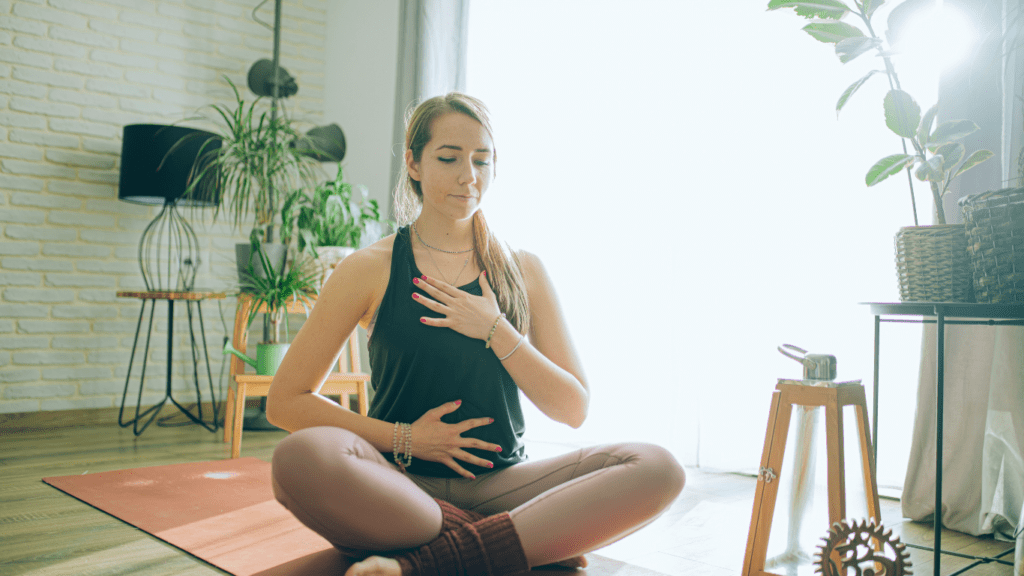
Benefit:
Diaphragmatic breathing strengthens the diaphragm and improves lung capacity. By encouraging deeper, more efficient breathing during sleep, this exercise helps ensure that your body receives adequate oxygen, which is crucial for managing sleep apnea. As you strengthen your diaphragm, you may find that your overall respiratory function improves, leading to fewer breathing disruptions at night.
B. Nadi Shodhana (Alternate Nostril Breathing)
Instructions:
- Get Comfortable: Sit in a comfortable position with your spine straight.
- Close the Right Nostril: Use your right thumb to close your right nostril.
- Inhale Deeply: Breathe in slowly and deeply through your left nostril.
- Switch Sides: Close your left nostril with your ring finger, release your right nostril, and exhale through the right.
- Repeat: Inhale through the right nostril, switch, and exhale through the left. Continue this alternating pattern for 5 to 10 minutes.
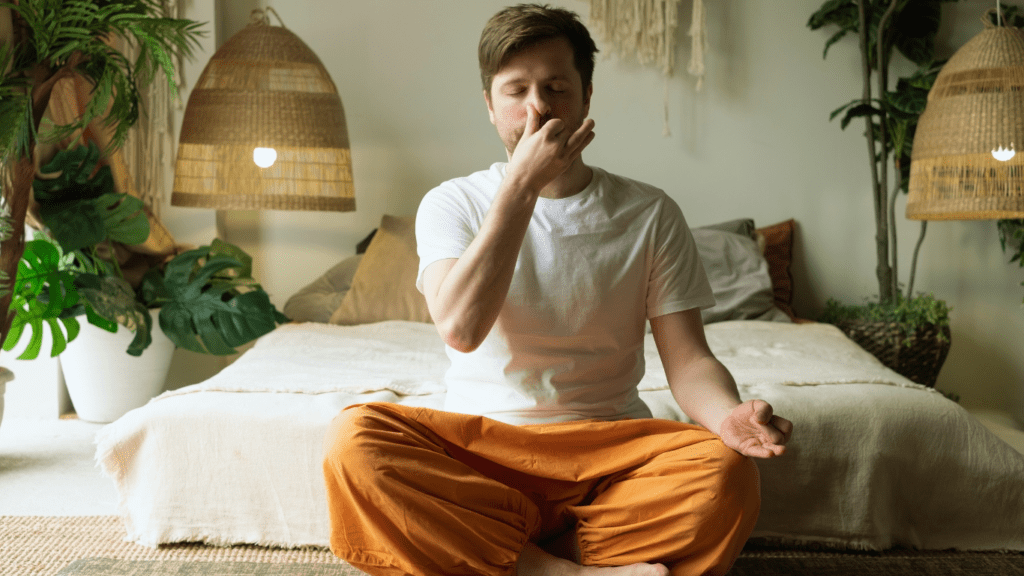
Benefit:
Nadi Shodhana balances the autonomic nervous system, which can help reduce the stress response that exacerbates sleep apnea symptoms. This exercise encourages calmness and relaxation, making it easier to fall asleep and stay asleep throughout the night. By improving your body’s stress response, you can reduce anxiety levels and promote a more restful sleep environment.
C. Bhramari (Humming Bee Breath)
Instructions:
- Sit Comfortably: Find a comfortable seated position with your eyes closed.
- Inhale Deeply: Take a deep breath in through your nose.
- Exhale with Sound: As you exhale, produce a gentle humming sound similar to that of a bee. Focus on the vibration in your throat and face.
- Repeat: Continue this humming for 5 to 10 minutes, inhaling and exhaling deeply.
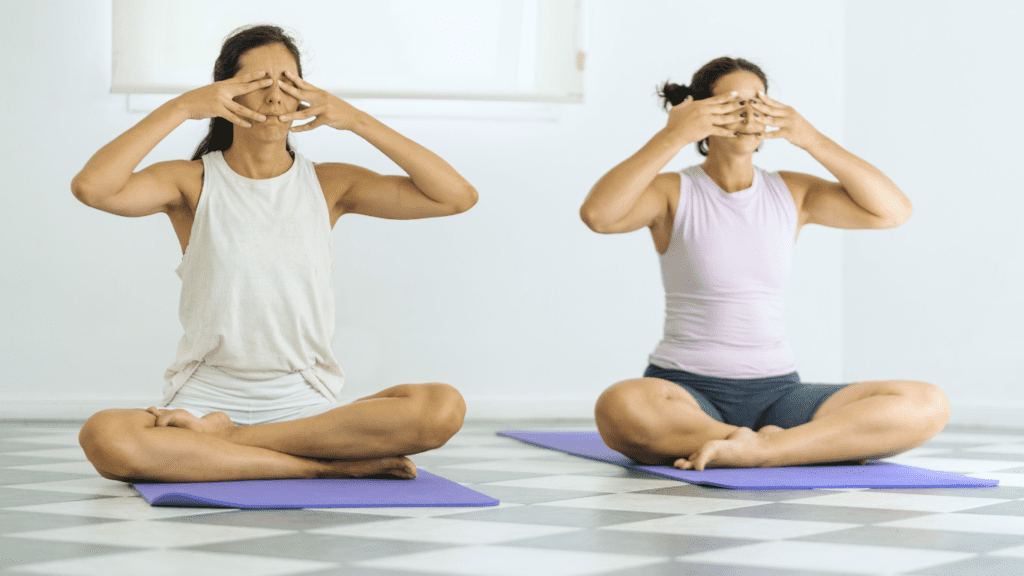
Benefit:
Bhramari relaxes the throat muscles, which can help reduce snoring and promote airway stability. The vibrations generated during this exercise stimulate the vagus nerve, leading to a calming effect on the mind and body. This relaxation is essential for improving sleep quality, as it allows for better airflow during sleep and can alleviate some of the discomfort associated with sleep apnea.
D. Ujjayi Breath (Ocean Breath)
Instructions:
- Find Your Center: Sit comfortably with a straight spine.
- Inhale Through the Nose: Breathe in deeply through your nose while gently constricting the back of your throat.
- Exhale Slowly: As you exhale through your nose, maintain the throat constriction to create a soft, ocean-like sound.
- Repeat: Continue this breathing pattern for 5 to 10 minutes, focusing on the sound and rhythm.

Benefit:
Ujjayi breath helps tone and strengthen the throat and airway muscles, reducing the likelihood of airway collapse during sleep. Additionally, this technique promotes deep relaxation, which is essential for improving sleep quality. The soft sound created during this exercise can also serve as a calming focal point, helping you transition into a more restful state.
E. Kapalabhati (Skull Shining Breath)
Instructions:
- Sit Upright: Begin by sitting upright in a comfortable position.
- Deep Inhale: Take a deep breath in through your nose, filling your lungs completely.
- Forceful Exhalation: Exhale forcefully through your nose while contracting your abdominal muscles. Inhalation should happen passively, without effort.
- Continue the Cycle: Perform 20-30 rapid breaths in a cycle, maintaining a steady rhythm.
- Rest: After completing the cycle, take a moment to breathe normally and relax.
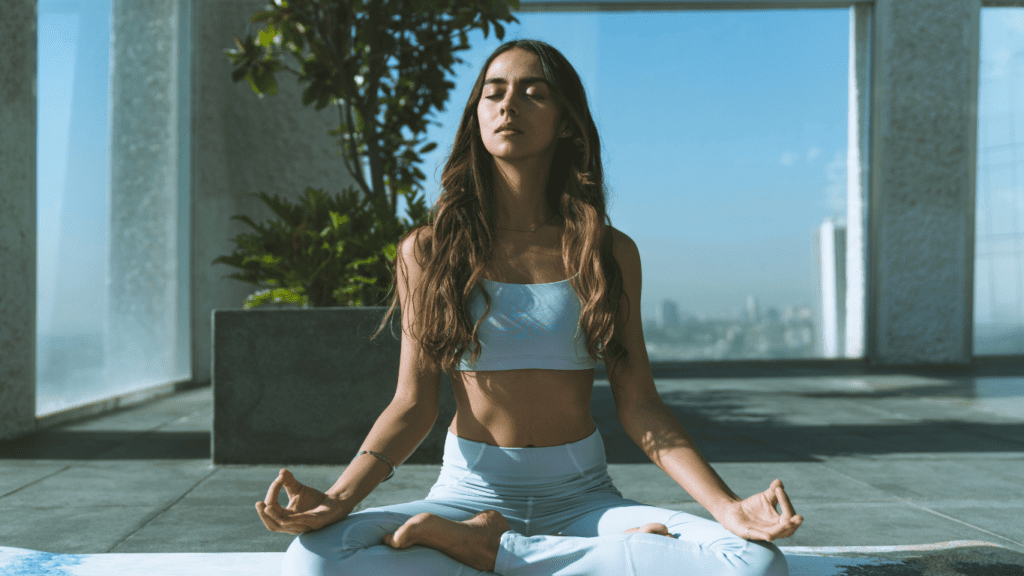
Benefit:
Kapalabhati improves lung capacity and strengthens the respiratory muscles, which can help prevent airway obstruction. This invigorating technique also helps cleanse the lungs and increase oxygen intake. By enhancing lung function and oxygen flow, this exercise can significantly benefit individuals with sleep apnea.
Incorporating yoga breathing exercises for sleep apnea into your daily routine can provide numerous benefits for your overall health and sleep quality. Each exercise targets specific aspects of breathing, helping to strengthen the respiratory system, reduce airway obstruction, and promote relaxation. Practicing these exercises regularly can lead to improved lung capacity, better oxygen flow, and a greater sense of calm—key factors in managing sleep apnea effectively.
It’s important to remember that while these exercises can be incredibly beneficial, they should complement any medical treatments or therapies recommended by your healthcare provider. If you are struggling with sleep apnea, consult with your doctor or a qualified professional before starting a new exercise regimen. By incorporating yoga breathing exercises for sleep apnea into your routine, you can take proactive steps toward better sleep and improved health.
The Science Behind Pranayama and Sleep Apnea
Why did the yogi refuse to take a nap? Because he wanted to be fully present in his dreams! While this might sound humorous, it underscores a vital truth: sleep quality is essential for overall health. Yoga breathing exercises for sleep apnea can play a crucial role in enhancing that quality by addressing the underlying issues associated with the condition. Studies have shown that effective breathing techniques can help improve sleep patterns and overall well-being.
Breathing Mechanics and Sleep Apnea
Understanding the mechanics of breathing is crucial in grasping how yoga breathing exercises for sleep apnea can be beneficial. Sleep apnea primarily stems from the collapse of the upper airway during sleep, which disrupts airflow and results in decreased oxygen levels in the body. This obstruction can lead to a host of health issues, including daytime fatigue, high blood pressure, and cardiovascular problems.
Research highlights the scientific rationale behind why deep, controlled breathing significantly improves sleep apnea. Engaging in pranayama exercises can help strengthen the respiratory muscles, enhance lung capacity, and increase oxygen flow throughout the body. A study published in the Journal of Clinical Sleep Medicine found that participants who practiced breathing exercises regularly experienced a reduction in the frequency and severity of apnea episodes. By training the diaphragm and surrounding muscles through pranayama, individuals can effectively mitigate airway obstruction and promote better airflow during sleep.
This improvement in lung function and respiratory efficiency is particularly important for those suffering from sleep apnea, as it directly contributes to a reduction in symptoms. As individuals learn to breathe more deeply and fully, they can experience less disruption during sleep, leading to a more restorative rest.
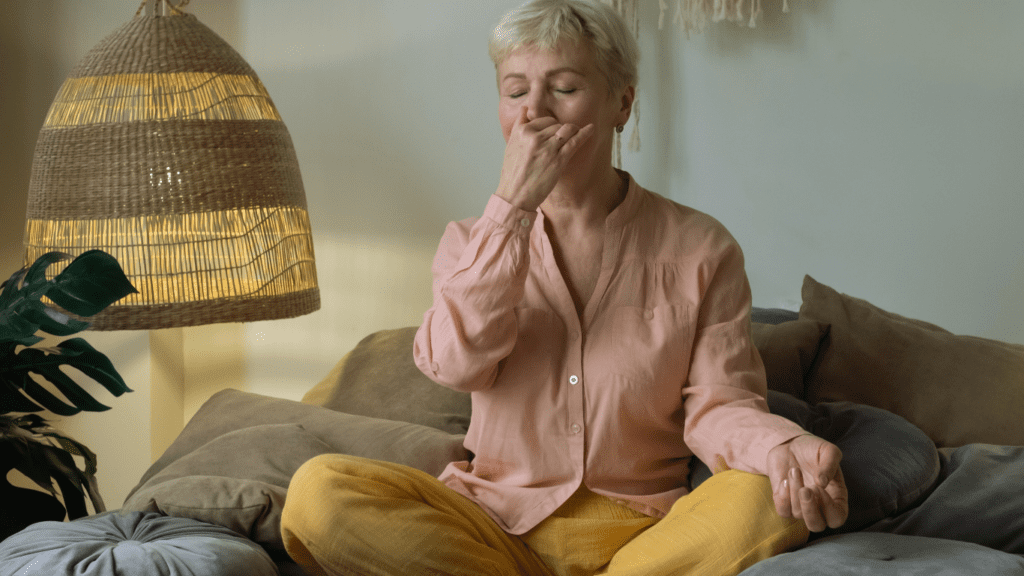
Calming the Nervous System
One of the most profound benefits of yoga breathing exercises for sleep apnea is their ability to activate the parasympathetic nervous system. This part of the nervous system is responsible for promoting relaxation and calmness, counteracting the stress response that can worsen sleep apnea symptoms.
Pranayama exercises encourage a shift away from the fight-or-flight mode that many experience due to daily stressors. By focusing on controlled breathing, individuals can reduce their heart rate and lower blood pressure, creating a state of calmness conducive to restful sleep. The more relaxed the body feels, the less likely it is to experience the disruptions associated with sleep apnea.
Furthermore, various studies have shown that regular practice of pranayama can lead to significant improvements in stress management. One research study found that individuals who engaged in deep breathing techniques reported lower anxiety levels and improved emotional regulation. For sleep apnea patients, this means that practicing pranayama can help maintain steady breathing patterns, reducing the likelihood of airway collapse during sleep.
Long-Term Benefits
The benefits of yoga breathing exercises for sleep apnea extend beyond immediate relief; they can also contribute to long-term improvements in overall health. Consistent practice of pranayama can lead to enhanced lung function, increased oxygen intake, and lower stress levels. Over time, these cumulative effects can result in significantly better sleep quality.
Moreover, many individuals who adopt a regular yoga breathing practice find that it enhances their overall sense of well-being. Improved sleep quality can lead to greater energy levels during the day, better cognitive function, and a more positive mood. This holistic approach to health makes yoga breathing exercises for sleep apnea not just a temporary fix, but a sustainable lifestyle choice.
Additionally, the long-term practice of pranayama has been associated with improved cardiovascular health, which is particularly important for sleep apnea patients. By reducing blood pressure and improving heart rate variability, individuals can mitigate some of the risks associated with sleep apnea.
In conclusion, the science behind yoga breathing exercises for sleep apnea reveals a powerful connection between breath control and improved health outcomes. By understanding the mechanics of breathing, calming the nervous system, and recognizing the long-term benefits of consistent practice, individuals can take significant steps toward managing their sleep apnea.
Incorporating these techniques into your daily routine can lead to better sleep quality, reduced symptoms, and an overall enhancement in quality of life. If you’re struggling with sleep apnea, consider exploring yoga breathing exercises for sleep apnea as a natural and effective way to support your health journey.
Chart: Enhanced Benefits, Ideal Practice Times, and Duration Recommendations for Yoga Breathing Exercises in Sleep Apnea Management
| Breathing Exercise | Additional Benefit for Sleep Apnea | Ideal Practice Time | Recommended Duration |
|---|---|---|---|
| Diaphragmatic Breathing | Improves oxygen exchange efficiency, essential for reducing nighttime disruptions | Evening before bed | 5-10 minutes |
| Nadi Shodhana | Balances nervous system, reducing the nighttime stress response and apnea severity | Evening; can also be used mid-day to reduce stress | 5-10 minutes |
| Bhramari (Humming Bee Breath) | Enhances vagus nerve function, promoting deep relaxation for uninterrupted sleep | 30 minutes before bed | 5-10 minutes |
| Ujjayi Breath | Strengthens airway muscles, lowering risk of snoring and airway obstruction | Early evening or pre-sleep routine | 5-10 minutes |
| Kapalabhati | Increases lung strength and clears nasal passages, supporting smoother airflow | Morning (invigorating start) and evening | 1-3 cycles of 20-30 breaths, with rest intervals |
Tips for Incorporating Yoga Breathing Exercises for Sleep Apnea into Daily Life
Why don’t scientists trust atoms? Because they make up everything! While this joke is light-hearted, it highlights an essential truth about our daily lives: everything is interconnected, including our breath. By integrating yoga breathing exercises for sleep apnea into your routine, you can create a healthier lifestyle that promotes better sleep and overall well-being. Here are some practical tips to help you incorporate these exercises effectively into your daily life.
Daily Routine
Establishing a consistent daily routine is key to reaping the benefits of yoga breathing exercises for sleep apnea. Aim to practice these exercises for about 5-10 minutes before bedtime. This dedicated time allows you to relax both your body and mind, preparing you for a restful night’s sleep. Consider finding a quiet, comfortable space where you can sit or lie down without distractions.
As you settle in, focus on your breath, employing techniques like diaphragmatic breathing to deepen your inhalations and exhalations. By doing this regularly, you signal to your body that it’s time to wind down, making it easier to transition into sleep. Moreover, a calming bedtime routine that includes these exercises can signal your brain to associate this practice with relaxation and sleep.
Mindful Breathing Throughout the Day
Incorporating mindful breathing techniques into your daily activities can significantly enhance the effectiveness of yoga breathing exercises for sleep apnea. Throughout the day, take a few moments to practice mindful breathing. Whether you’re at work, commuting, or running errands, these brief moments of focus can keep your respiratory system strong and your nervous system balanced.
When you find yourself feeling stressed or anxious, pause for a moment to take a few deep breaths. Inhale deeply through your nose, allowing your abdomen to expand, and then exhale slowly through your mouth. This practice not only helps to improve lung function but also reinforces the principles of pranayama that you apply during your bedtime routine. By integrating mindful breathing into your daily life, you create a more balanced and resilient body.
Sleep Positioning
In addition to practicing yoga breathing exercises for sleep apnea, consider your sleep position. Certain positions can complement your breathing practices and further reduce sleep apnea symptoms. Research suggests that sleeping on your side can help alleviate airway obstruction, reducing the likelihood of sleep disturbances.
When lying on your side, gravity helps keep the airway open, making it easier to breathe. If you find yourself rolling onto your back during the night, consider using a body pillow to support your position. This can help maintain the side-sleeping posture you want while preventing you from shifting into a position that may exacerbate sleep apnea.
You might also experiment with a slightly elevated sleeping position. Using a wedge pillow or adjusting the head of your bed can help keep your airways open and encourage better airflow. When combined with yoga breathing exercises for sleep apnea, these adjustments can create a more conducive environment for restorative sleep.
In summary, incorporating yoga breathing exercises for sleep apnea into your daily life is a straightforward yet effective way to enhance your overall health and improve sleep quality. By establishing a dedicated practice before bed, engaging in mindful breathing throughout the day, and adjusting your sleep positioning, you can create a comprehensive approach to managing sleep apnea.
Taking the time to focus on your breath can yield significant long-term benefits, including improved lung function, reduced stress, and better sleep quality. Remember, every breath counts—so make them count for your well-being!
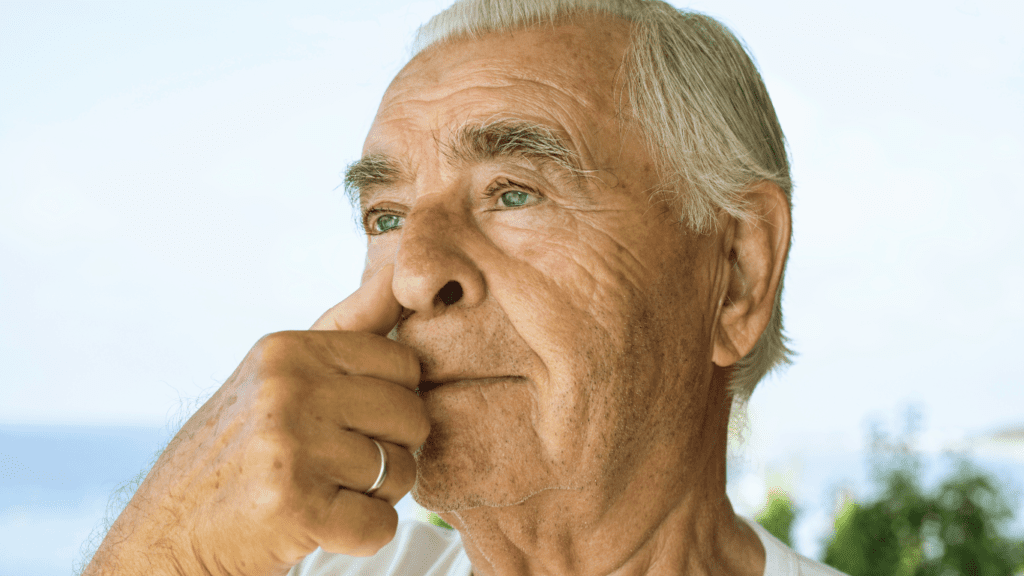
Wrapping Up: The Impact of Yoga Breathing Exercises for Sleep Apnea
As we’ve explored throughout this article, yoga breathing exercises for sleep apnea can serve as a natural and effective approach to managing this condition. These practices not only help improve respiratory function but also provide a sense of calm and relaxation that is essential for quality sleep. Here’s a brief summary of how these exercises can benefit you:
- Natural Management: Yoga breathing exercises offer a holistic way to tackle the symptoms of sleep apnea. By focusing on breath control, these techniques can strengthen respiratory muscles and enhance airflow, which is crucial for those affected by airway obstructions.
- Consistent Practice: The importance of a consistent practice cannot be overstated. Regularly engaging in yoga breathing exercises for sleep apnea will help your body adapt, leading to improved lung capacity and more efficient breathing over time.
- Complementing Lifestyle Changes: Pairing these exercises with other lifestyle modifications, such as weight management and a balanced diet, can amplify their effectiveness. Maintaining a healthy weight can reduce the severity of sleep apnea, while a nutritious diet supports overall health.
- Empowering and Non-Invasive: One of the most significant advantages of these breathing techniques is that they are non-invasive. Unlike other treatments, they empower individuals to take control of their health and well-being without relying solely on medical interventions.
- Community Support: Sharing your journey and experiences with others can be incredibly motivating. Encouraging a dialogue within your community can provide additional tips, support, and insights into managing sleep apnea.
Incorporating yoga breathing exercises for sleep apnea into your daily routine can be a transformative step towards better health and improved sleep quality. Don’t hesitate to try out these exercises and discover how they can benefit you. Remember, every breath counts, and taking charge of your breathing is a powerful step towards alleviating the symptoms of sleep apnea.
Frequently Asked Questions
1. What is sleep apnea?
Sleep apnea is a sleep disorder characterized by repeated interruptions in breathing during sleep, leading to fragmented sleep and decreased oxygen levels.
2. How do yoga breathing exercises help with sleep apnea?
Yoga breathing exercises improve lung capacity, strengthen respiratory muscles, and promote relaxation, helping to reduce airway obstruction and improve sleep quality.
3. How often should I practice yoga breathing exercises?
Aim to practice these exercises for at least 5-10 minutes daily, especially before bedtime, to experience optimal benefits.
4. Can yoga breathing exercises replace medical treatments for sleep apnea?
While these exercises can significantly improve symptoms, they should be used as a complementary approach alongside medical treatments recommended by healthcare providers.
5. What lifestyle changes can help manage sleep apnea?
Maintaining a healthy weight, adopting a balanced diet, avoiding alcohol, and sleeping on your side can all help manage sleep apnea symptoms.
6. Is there a specific breathing exercise that is best for sleep apnea?
Each exercise has its unique benefits. Diaphragmatic breathing and alternate nostril breathing are particularly effective in improving lung function and reducing stress.
7. Can I practice these exercises if I have never done yoga before?
Absolutely! Yoga breathing exercises are accessible to everyone, regardless of their prior experience with yoga.
8. Are there any risks associated with yoga breathing exercises?
Generally, these exercises are safe; however, individuals with respiratory conditions should consult their healthcare provider before starting any new breathing techniques.
9. How can I incorporate these exercises into my daily routine?
Set aside specific times for practice, like before bed or during breaks in your day. You can also engage in mindful breathing whenever you feel stressed.
10. Where can I find resources to learn more about these exercises?
Many online platforms, yoga studios, and books provide detailed instructions on various yoga breathing exercises. Look for resources that emphasize their application for sleep apnea.
Share Your Experience
We would love to hear from you! Please share your experiences and thoughts in the comment section below. Your insights could inspire others who are navigating similar challenges.

